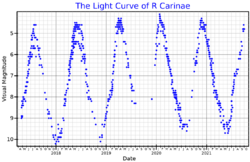Astronomy:R Carinae
| Observation data Equinox J2000.0]] (ICRS) | |
|---|---|
| Constellation | Carina |
| Right ascension | 09h 32m 14.59964s[2] |
| Declination | −62° 47′ 20.0452″[2] |
| Apparent magnitude (V) | 3.9 - 10.5[3] |
| Characteristics | |
| Evolutionary stage | AGB[4] |
| Spectral type | M6/7pe[5] |
| B−V color index | 0.906±0.009[6] |
| Variable type | Mira[3] |
| Astrometry | |
| Radial velocity (Rv) | +28.1±1.0[6] km/s |
| Proper motion (μ) | RA: −37.900[2] mas/yr Dec.: +22.232[2] mas/yr |
| Parallax (π) | 2.5813 ± 0.4460[2] mas |
| Distance | approx. 1,300 ly (approx. 390 pc) |
| Absolute magnitude (MV) | 1.48[6] (at mv = 7.43) |
| Details | |
| Mass | 0.87+0.47 −0.31[4] M☉ |
| Radius | 241.0+37.6 −32.6[4] R☉ |
| Luminosity | 4,571+1,331 −1,031[4] L☉ |
| Temperature | 2,800[7] K |
| Other designations | |
| Database references | |
| SIMBAD | data |
R Carinae is a double star in the southern constellation of Carina. The brighter component is a variable star that can be viewed with the naked eye at peak brightness,[9] but is usually too faint to be seen without a telescope, having an apparent visual magnitude that fluctuates around 7.43.[6] This star is located at a distance of approximately 1,300 light years from the Sun based on parallax, and is drifting further away with a radial velocity of +28 km/s.[6]
The main component is an aging red giant star on the asymptotic giant branch[4] with a stellar classification of M6/7pe.[5] It is classified as a pulsating Mira type variable star and its visual brightness varies with an average amplitude of 4.25 magnitudes over a period of 303.99±1.08 d. Its average maximum visual magnitude is 5.05±0.45,[9] but the brightest observed maximum was magnitude 3.9[3] This star is surrounded by a dusty shell, with properties that are consistent with iron-poor silicates or corundum, extending from around three stellar radii outward.[10]
The companion is a magnitude 11.30 star at an angular separation of 2.10″ along a position angle of 132° from the main star, as of 2015.[11]
References
- ↑ "Download Data". AAVSO. https://www.aavso.org/data-download.
- ↑ 2.0 2.1 2.2 2.3 2.4 Brown, A. G. A. (August 2018). "Gaia Data Release 2: Summary of the contents and survey properties". Astronomy & Astrophysics 616: A1. doi:10.1051/0004-6361/201833051. Bibcode: 2018A&A...616A...1G. Gaia DR2 record for this source at VizieR.
- ↑ 3.0 3.1 3.2 Samus, N. N. et al. (2017), "General Catalogue of Variable Stars", Astronomy Reports, 5.1 61 (1): 80–88, doi:10.1134/S1063772917010085, Bibcode: 2017ARep...61...80S.
- ↑ 4.0 4.1 4.2 4.3 4.4 Takeuti, Mine et al. (2013), "A Method to Estimate the Masses of Asymptotic Giant Branch Variable Stars", Publications of the Astronomical Society of Japan 65 (3): 60, doi:10.1093/pasj/65.3.60, Bibcode: 2013PASJ...65...60T.
- ↑ 5.0 5.1 Houk, Nancy; Cowley, A. P. (1979), Michigan catalogue of two-dimensional spectral types for the HD stars, 1, Ann Arbor, Michigan: Dept. of Astronomy, University of Michigan, Bibcode: 1978mcts.book.....H.
- ↑ 6.0 6.1 6.2 6.3 6.4 Anderson, E.; Francis, Ch. (2012), "XHIP: An extended hipparcos compilation", Astronomy Letters 38 (5): 331, doi:10.1134/S1063773712050015, Bibcode: 2012AstL...38..331A.
- ↑ McDonald, I.; Zijlstra, A. A.; Boyer, M. L. (2012), "Fundamental parameters and infrared excesses of Hipparcos stars", Monthly Notices of the Royal Astronomical Society 427 (1): 343, doi:10.1111/j.1365-2966.2012.21873.x, Bibcode: 2012MNRAS.427..343M.
- ↑ "R Car". SIMBAD. Centre de données astronomiques de Strasbourg. http://simbad.u-strasbg.fr/simbad/sim-basic?Ident=R+Car.
- ↑ 9.0 9.1 Vogt, N. et al. (2016), "Determination of Pulsation Periods and Other Parameters of 2875 Stars Classified As Mira in the All Sky Automated Survey (Asas)", The Astrophysical Journal Supplement Series 227 (1): 6, doi:10.3847/0067-0049/227/1/6, Bibcode: 2016ApJS..227....6V.
- ↑ Ireland, M. J. et al. (July 2005), "Dust scattering in the Miras R Car and RR Sco resolved by optical interferometric polarimetry", Monthly Notices of the Royal Astronomical Society 361 (1): 337–344, doi:10.1111/j.1365-2966.2005.09181.x, Bibcode: 2005MNRAS.361..337I.
- ↑ Mason, B. D. et al. (2014), "The Washington Visual Double Star Catalog", The Astronomical Journal 122 (6): 3466, doi:10.1086/323920, Bibcode: 2001AJ....122.3466M.
 |


